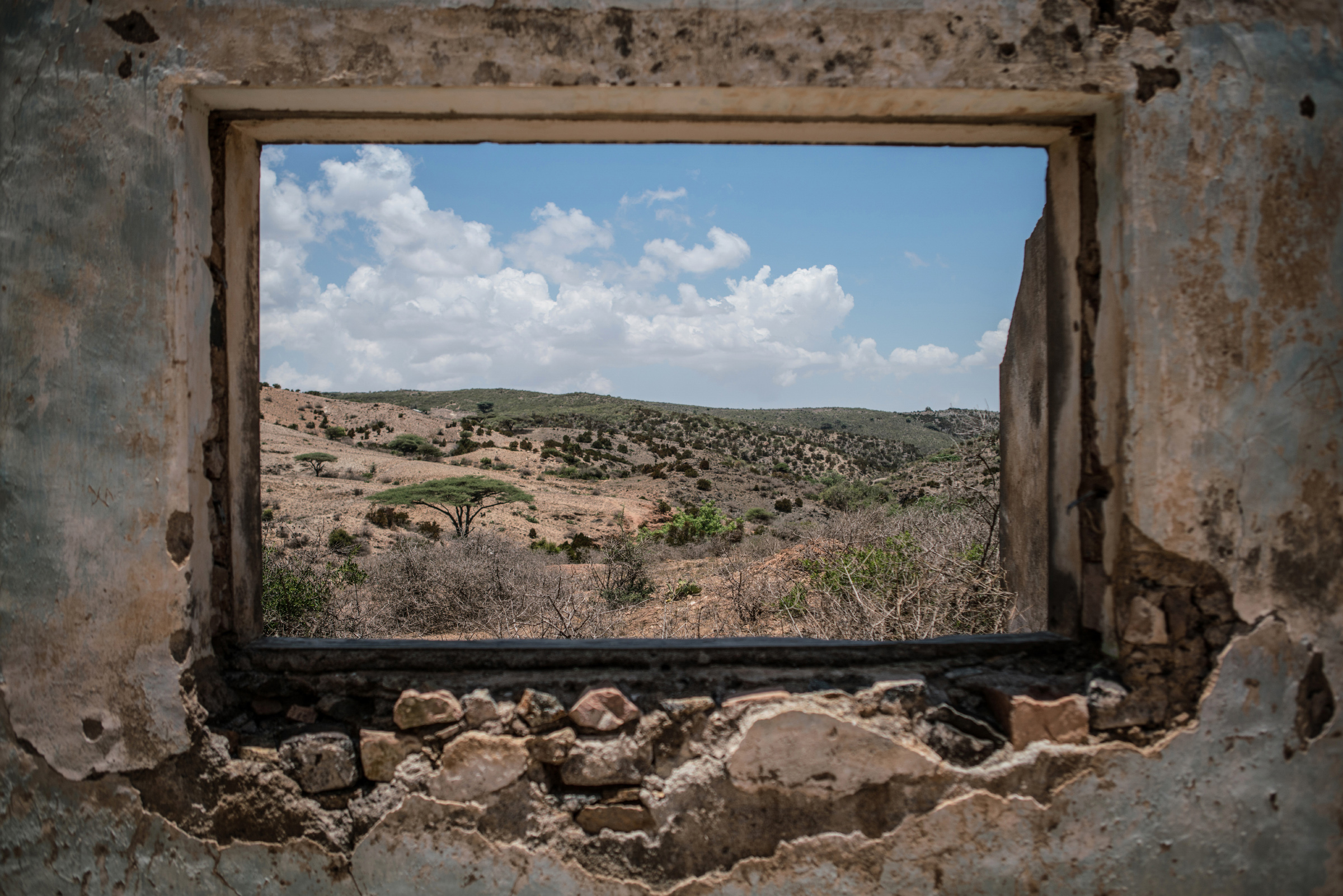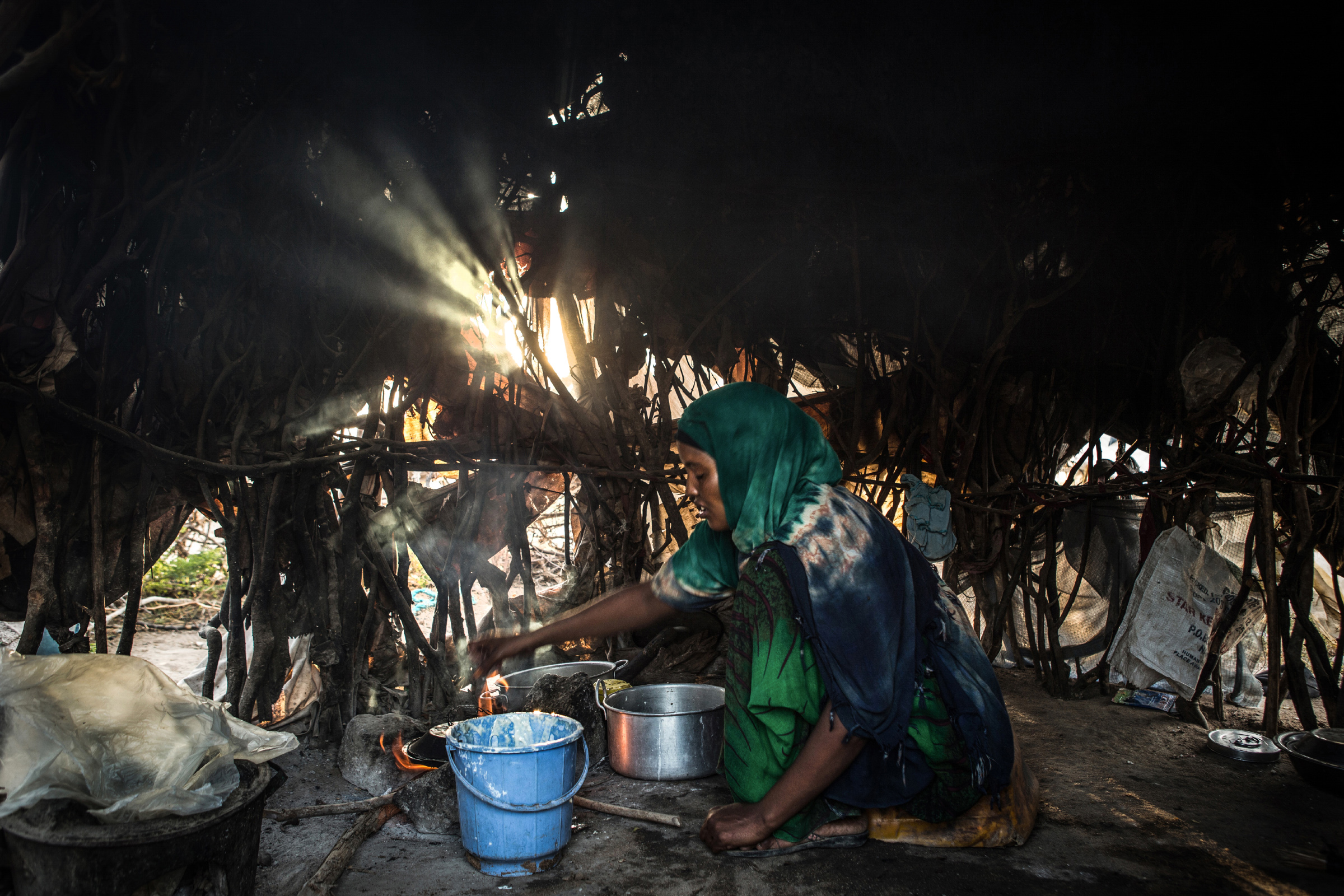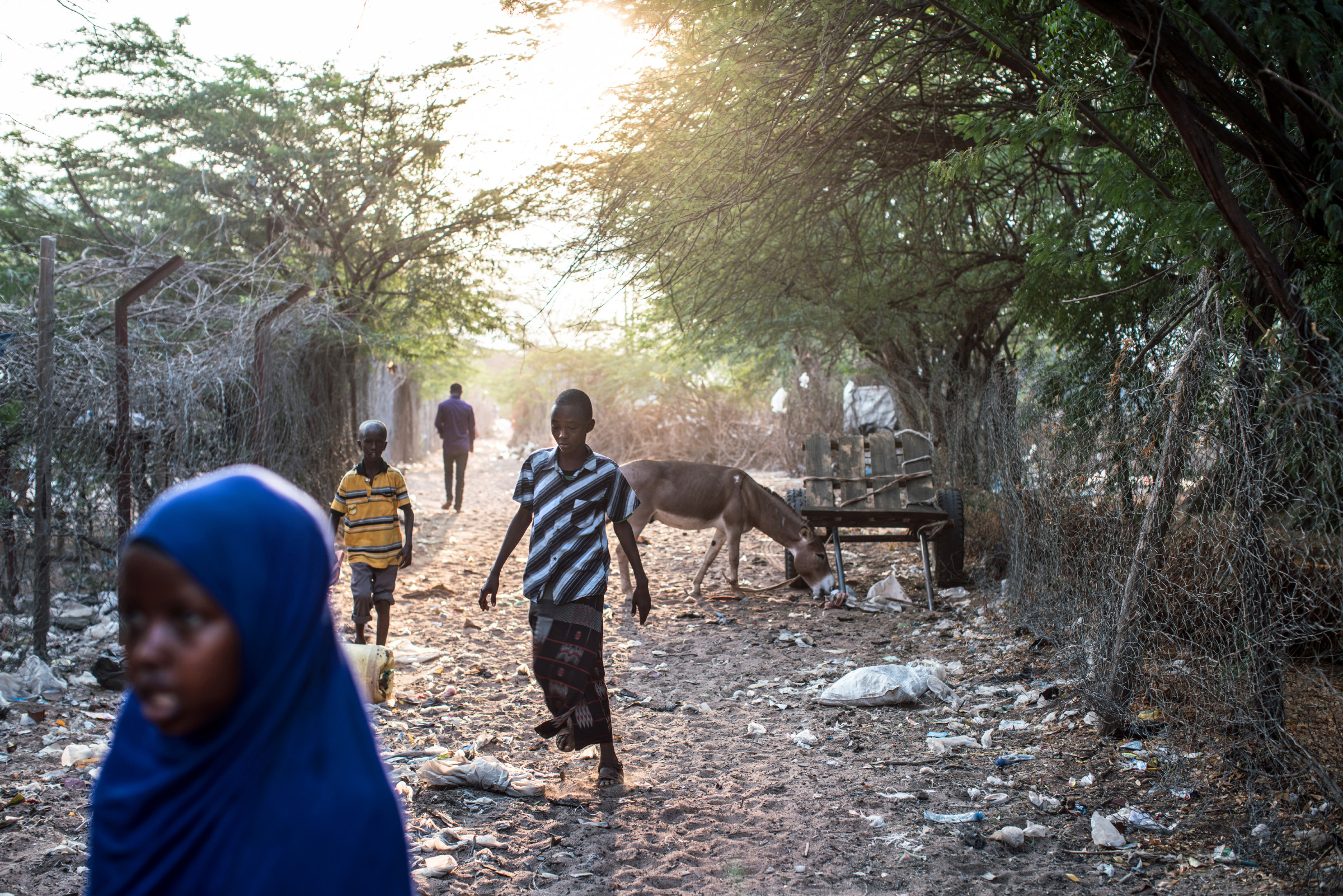Somalia’s Climate for Conflict:
Introduction
Climate change is increasingly fueling conflict in Somalia, and pushing one of the world’s most resilient communities to the brink. In this hot and dry country in the Horn of Africa, where average rainfall is down 15 percent, drought has become an inescapable way of life. Desperation – and hunger – are driving people to swollen cities, to refugee camps, or to the ranks of the militant group al-Shabab.
For the last year, GroundTruth fellows Laura Heaton and Nichole Sobecki have reported from the dangerous and mostly barren lands of northern Somalia and the crowded neighborhoods of one the world’s largest refugee camps, in Dadaab, Kenya, to explore how climate change is an underlying cause of violence, terrorism and migration. It’s part of our series, Living Proof: The Human Toll of Climate Change.
See Nichole and Laura’s reporting below, as well as on ABC Nightline (May 29, 2017 broadcast) and in Foreign Policy magazine (May/June 2017 issue). Listen to them on Foreign Policy’s podcast, where they describe the behind-the-scenes of their 18 month reporting trip.
And view the short film that is now the centerpiece of an impact campaign to start conversations about how irreversible climate change is leading to instability, conflict and migration.
Somalia’s Climate for Conflict:
How drought brings war to Somalia
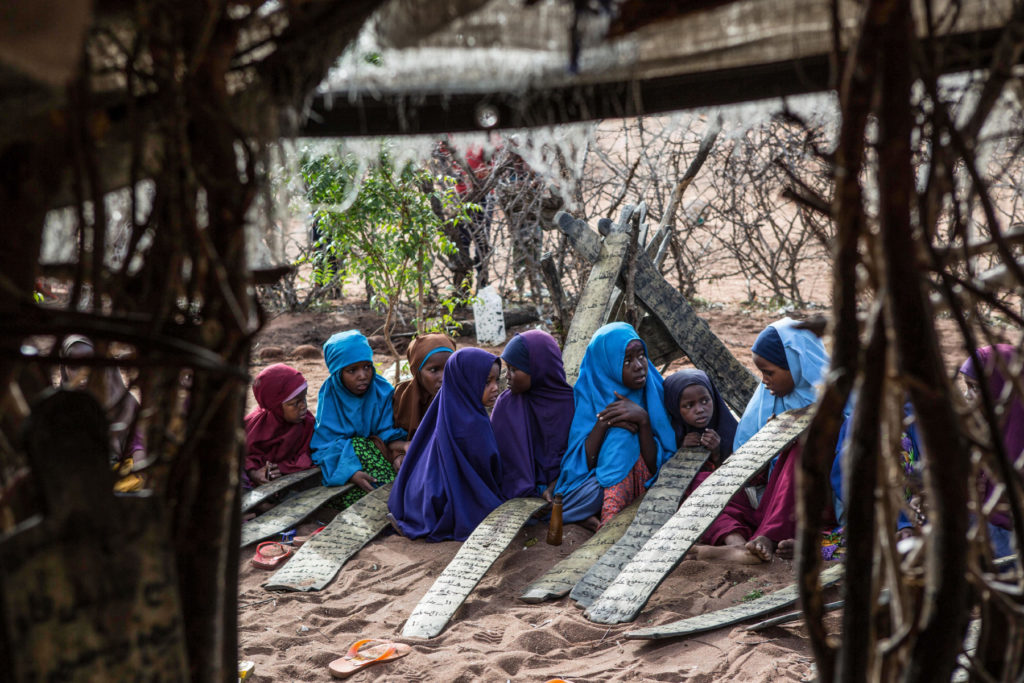
Mohamed Mohamed was once imprisoned by the extremist group al-Shabab, and after his five-day ordeal, he walked from Somalia to Kenya for 27 days with his wife and two daughters, during what was widely described as the worst drought in 60 years. But now, even from the safety of the refugee camp where his family has lived since 2011, Mohamed says he’s distraught.
“I have sleepless nights and worry a lot,” he says. “I am even worried that I can get high blood pressure because of thinking a lot.”
Now a father of five, including two young sons – 4-year-old Muad and 3-year-old Abdullahi – Mohamed knows his family can’t stay in the refugee camp in Kenya forever. The Kenyan government regularly threatens to close the camp, citing security concerns, and doesn’t allow refugees to become citizens. But he also can’t imagine returning to Somalia.
“I don’t want my children to even live in area where they see guns or fighting. You saw the little boy,” Mohamed says, referring to Muad, who a moment before was making funny faces and doing tricks. “What happens if he ends up at the hands of bad people? So I don’t want them to experience such life.”
Al-Shabab is an extremist group tied to al-Qaeda. The militants took control of large parts of the country starting in the mid-2000s, and today claim thousands of square miles across Somalia, including Mohamed’s home area. They enforce Sharia law and run training camps for foreign fighters. They regularly launch attacks in Somalia, and more recently they’ve ventured into neighboring Kenya – starting with the 2013 Westgate mall attack that killed about 70 people.
Mohamed says that, in Somalia, al-Shabab recruits boys at the madrassas (religious schools), and parents have little power to counter that influence.
“I am fearful that they will be recruited. First, there is no school other than those run and controlled by them,” he says. “The other thing is they can radicalize you because you are poor and don’t have anything.”
And his daughters? “The boys and girls are not different,” he says. “The girls will be forcibly married” to al-Shabab fighters. He adds that humanitarian organizations are blocked from areas controlled by al-Shabab.
“The reason [al-Shabab] banned all the aid agencies that would have helped the people is to attract the hungry people, knowing too well that people facing starvation will fall for anything,” Mohamed says.
In Somalia, he had a farm on a piece of land he inherited from his father. His crops – maize, sorghum, sesame, and watermelon – were fed by the rains, and two wet seasons used to suffice. But Mohamed has noticed a change in the weather and seasons since his father’s time, and when the notorious 2011 drought hit, “everything got destroyed,” he says.

“The worst is the drought, because with something to eat you can tolerate jail or any punishment,” he says. “But facing starvation is worse than insecurity.”
Mohamed is among a quarter of a million Somalis who live in Dadaab refugee camp, in crowded makeshift houses – some of them since the start of the civil war in their country in 1991. In the camp, Mohamed’s home is like a typical Somali homestead: several domed structures built of wooden frames, covered with a patchwork of tarps and cloth. One hut is the living room, another the family bedroom, and a smaller one is the kitchen. There’s a pen for the goats, surrounded by thorn bushes. This morning, Mohamed’s wife Habiba is making a breakfast of flatbread and tea.
In the living room hut, the dirt floors are swept flat and clean. We sit with Mohamed on plastic mats to talk.
This fear of starvation is also one of the concerns that runs through his mind at night while his family sleeps. Mohamed doubts he could make a life in Somalia as a farmer again. He no longer has farming equipment or money for seeds, and his land has likely been taken over by others. And, he hears from friends who have gone back that the drought persists. Starving terrifies him even more than al-Shabab.
“Even if Somalia has security problems, if someone has to die, it’s best if he dies while in good shape, other than dying of hunger,” Mohamed says.
***
For the past year, photojournalist Nichole Sobecki and I have been on a mission to understand how climate change and environmental degradation drive conflict in Somalia. It’s a place where people are feeling the effects of climate change right now. Average temperatures are rising and rain falls less often and in smaller amounts. Drought experts estimate that average rainfall is down about 15 percent. That wouldn’t make much difference if you live in a place like Seattle or London. But in Somalia, a mostly desert country where people make the most from the few inches of rain they get – every little bit counts.
Somalia is a country of nomads, people who live – and die – migrating to places where they can find pasture and water for their animals. But people say they’re being forced to move farther and farther away from their typical routes. And as water sources and pastureland dry up, many Somalis are being pushed out of their homeland all together, over borders and across seas. Six years ago, the famine Mohamed’s family fled left a quarter of a million Somalis dead and nearly 300,000 seeking refuge in neighboring countries.
The droughts in Somalia are getting longer and more frequent. Scientists believe the impact of climate change has forced people to use up resources – cutting down trees, using up scarce pasture land – and sparked migration. Effects of climate change like these in Somalia are what the U.S. Defense Department calls “a threat multiplier,” fueling conflict and the extremism of terrorist groups like al-Shabab. Recent news reports indicate the U.S. is once again stepping up its presence in Somalia in a “shadow war” against the al-Qaeda-linked al-Shabab.
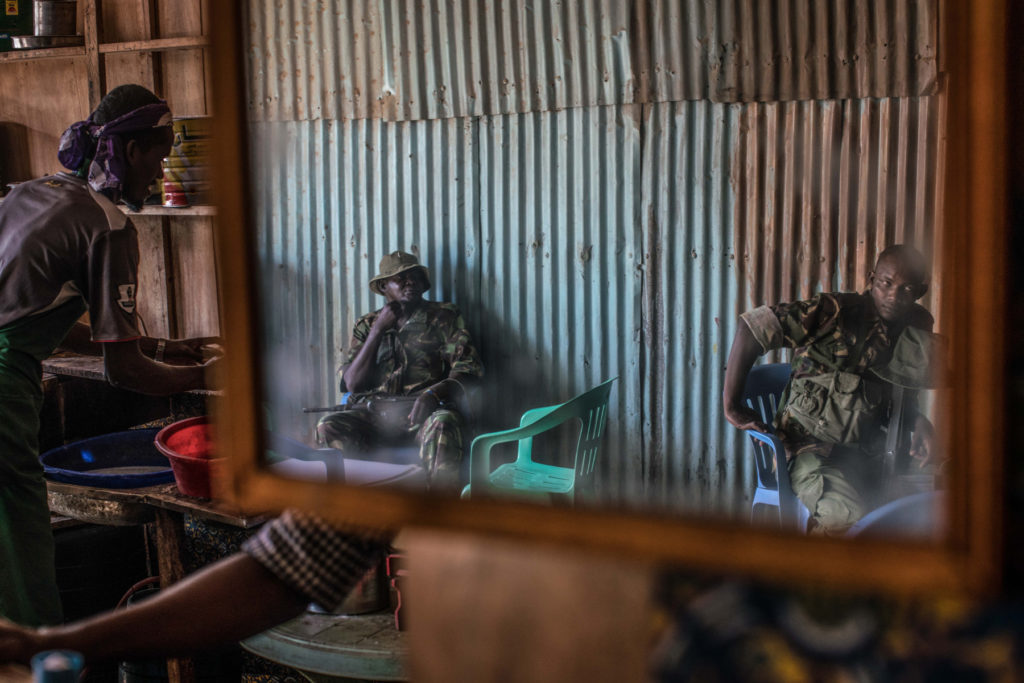
One of al-Shabab’s ploys to attract recruits is to offer protection, food and money. The tactic can be frighteningly effective, as Mohamed fears.
Nichole and I want to hear from someone who can talk personally about the lure of radicalization, someone who was drawn into that life and joined al-Shabab. But it will take some coordination, given the sensitivity of the topic.
A local journalist in Dadaab, who also works as our translator, is willing to reach out to his contacts who he knows formerly had ties with al-Shabab. For safety reasons, he asked that we not use his real name, so I’ll call him Youssef. He came to the camp as a 5-year-old when his family fled Mogadishu at the start of the civil war 25 years ago.
“Working as a journalist here in the camp is a bit difficult,” Youssef says. “You know there were so many journalists who have been killed in Somalia, so that had affected me here in the camp also.” Journalists are regularly targeted and murdered in Somalia, and even in the camp security can be questionable. His mother worried about his safety, asked him to stop this work. Become a businessman or something, she would say. But Youssef says journalism, to him, is not just a job.
“It’s not only because of work. It’s because of passion,” he says.
The work comes at a cost, and at times, he’s had to stop reporting in the face of threats. He’s been called an infidel, a spy for the Americans. “In reality, I was just a refugee who was just willing to work as a journalist,” Youssef says.
As a journalist, Youssef has tracked down a few former al-Shabab militants in the refugee camp. But he’s never been able to get any of them to talk on the record – and he’s tried for years. Contacting former al-Shabab fighters is dangerous – both for the former fighters, and for Youssef. That’s why we’re not using his real name. He could be targeted by Kenyan authorities, or even al-Shabab itself.
Youssef says he’s been trying to convince two former al-Shabab members to talk with us. “One was saying that he is even fearing his life,” Youssef says. “He was sent on mission in Somalia to fight but he has ditched and walked away to the camp. Another time he said that if the Kenyan government know about that he was a former [al-Shabab member] then he’ll have another problem, so he said, ‘I’m on fire on both ends.’”
“Trust is the problem here,” Youssef says. “The problem is this fear in the community, fear from the Kenyan government, fear that, do you know who you are talking to?”
Trust is at an all-time low in Dadaab. The Kenyan government is claiming the refugees pose a terrorist threat. And the refugees say some Somalis have been “disappeared” by masked members of the Kenyan Anti-Terrorism Police Unit. A Kenyan official admitted that some police abuse their power and kill Somalis they suspect of being connected to al-Shabab, but he said those police are prosecuted if they’re caught.
The only way the former fighter will agree to tell his story is if Youssef interviews him. Youssef tells us the former fighter worries two American journalists “might be an FBI agent or they might be CIA.” So Youssef takes an audio recorder and our questions to the interview, and the former al-Shabab member opens up about why he joined.
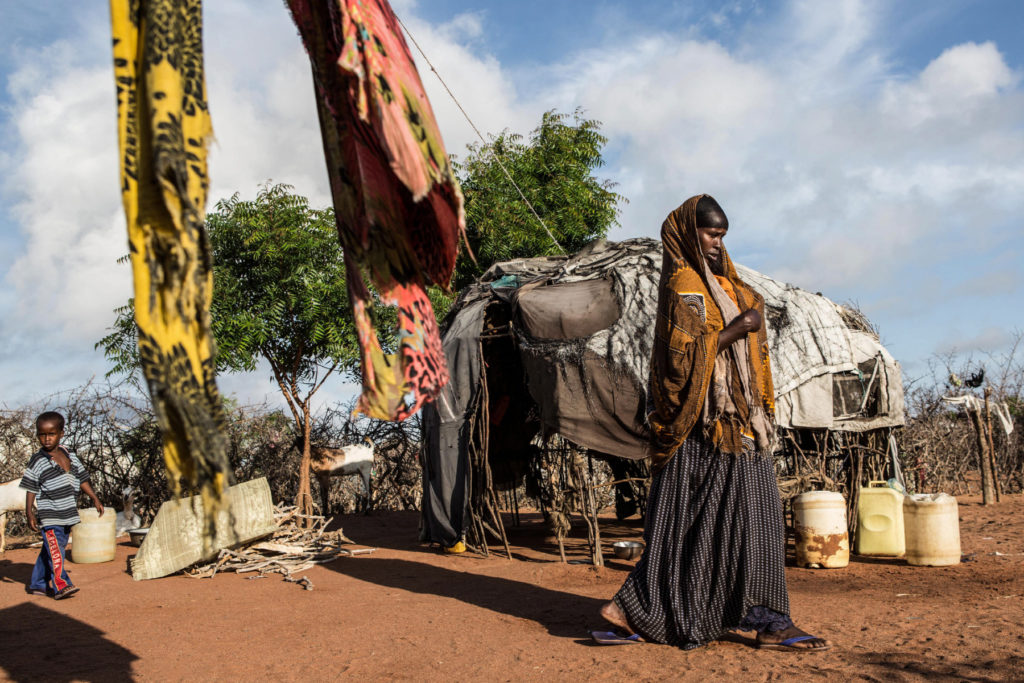
The next day we play back the recording of the interview, and Youssef translates. The former al-Shabab fighter doesn’t want his name used in our reporting, so we’ll call him Khalid. He’s around 30 years old, and Youssef says he’s thin, with a short beard and a cool demeanor.
“Some good days passed us, because we used to grow mangoes, and during the harvest we used to eat the mangoes and some other vegetables grown in the farm,” Khalid says. “But at last, something bad happened, and that is the drought.”
“I was working hard, but during the last days the farm wasn’t producing well, and I consulted some of my friends, some family members, and I decided to join them.” Khalid never mentions al-Shabab by name, referring instead to “them” or “the guys.” He says they used to come to his farm and demand a third of the harvest as a tax. He joined them in 2008.
“When I joined them there was no more taxation imposed against me,” Khalid says. “And I felt like now – how should I put? – I feel like I’m now a blessed person, because I have enough things to eat.”
So Khalid joined al-Shabab to keep that portion of his harvest – choosing extremism for himself over starvation for his family. Youssef didn’t talk to Khalid about the crimes he committed as a militant – Khalid wouldn’t discuss it. But during the two years he was part of al-Shabab, the group was responsible for extortion, terror attacks and recruitment of child soldiers.
“Before the drought, things were OK. We lived in a good life,” says Khalid on the recording. “There was enough produce of farming. And everybody was happy in the village where I lived. But it was this combination of the drought and these bad guys who had come.”
The translator, Youssef, explains that the former fighter wasn’t drawn in by their extremist preachings.
“The reason he joined them is not because he loved the ideology or he loved them,” Youssef says. “It was to safeguard his farm’s harvest. So the only thing he had in mind, the only way he can save his produce was joining them so that he avoids being taxed.”
With climate change, periods of drought are becoming more frequent and severe. Khalid’s town is still controlled by al-Shabab. So what would prevent him from joining up again if he is forced to go back?
Somalia’s top environmental official, Buri Hamza, talked with us about this dynamic last May. He made the connection between extremism and Somalia’s environmental problems – problems that are getting worse with climate change.
“The fact that many of our youth have lost jobs because of desertification, deforestation … It’s not the only cause, of course, of radicalization, but this is one of the major causes of radicalization because of the linkages between violence and environmental degradation,” Hamza said.
Hamza said the Ministry of Environment has a fraction of the budget it needs. He said that it’s difficult to get other Somali government officials and international donors to focus on environmental protection. Basic security in the country is still the most pressing problem. When Nichole and I were in Mogadishu, we drove around in an armored car and had two pick-up trucks full of armed guards with us all the time.

But despite the risks, Hamza moved back to Mogadishu in 2012 from Canada, while his wife and two children stayed safely behind. He traveled frequently to try and attract attention – and money – to fund environmental projects.
Hamza’s pitch was convincing, but he admitted it was hard to get people on board.
“Unless we really look into the underlying causes of conflict, I don’t really think that we will be able to bring about a lasting solution,” he said.
A month after our interview, members of al-Shabab detonated a car bomb outside a Mogadishu hotel and stormed the building, shooting people and taking hostages.
Fifteen people were killed in the attack, including Buri Hamza.
****
In the countryside in Somalia and away from al-Shabab’s hold a changing environment also upsets the fragile equilibrium, where people get by according to the amount of rain that falls each year.
We arrive in one remote Somali community as it’s reeling from a murder that happened just two weeks before. It’s not even a village – just several houses clustered near a well, surrounded by miles of barren terrain. At the well, men sing in time as they heave up buckets of water for their animals. The serene setting belies an underlying tension. Ali Yusuf Adan, a cousin of the man who was killed, says the changing environment is making people desperate and pushing them to violence.
“A decade ago, we had more rain than we needed. The climate was good and we didn’t have a lot of conflict,” he says. “But now the rains come less, and people have begun to fence off grazing land. If people fence off the communal land, and we don’t have much rain, conflict will always be a part of our life.”
Ali takes us to a clearing close by, where wind whips up huge clouds of dust. There’s no grass here anymore. The one tree has a gaping chunk blown away: a splintery bullet hole. “Both men were coming from the well that morning with their animals,” Ali says. “One of them hid along the path and shot the other dead.”
The two men had been fighting over a small patch of pasture, some of the only vegetation left after a recent drought lasted several months. One of the men had been protecting the land and cultivating food for his goats and camels; the other man had just arrived in the area, and his animals were on the brink of starvation. This is the way that cycles of conflict start. They begin with competition over resources – water, pasture, trees – and they become about retaliation.
A health clinic 20 minutes away from Ali’s home also functions as the mortuary. The medic who runs the clinic, Farax Arab, prepared the death certificate for the man who was shot. Farax says he’s worried about the violence this killing might spark. “Cases like this are becoming more common, which worries me,” Farax says. “The criminals escape easily, the victims pile up. What can we do? It’s like a chain. It goes on and on.”
Somali-American environmental activist Fatima Jibrell shares Farax’s worry. “The pastoral way of life is at risk, it cannot sustain,” Fatima says. After Somalia’s government collapsed in 1991, she foresaw environmental disaster and started an organization now called Adeso that focuses on helping nomadic families preserve the natural resources their lives depend on. But she’s losing faith it will work in the long run.
“I’m betting we’ll vanish from the earth. Somalis will vanish from Somalia,” she says. “And you know what? It’s not going to vanish only due to drought; it’s going to vanish due to drought that will bring wars, because we will fight like chickens with a small amount of crumbs. We’ll eat each other alive because this environment is not giving us anymore.”
For Mohamed and the millions of refugees like him living in camps beyond Somalia’s borders, and for Ali, who worries whether his cousin’s murder over scarce pasture land will set off a chain of violence, Fatima’s prophecy is already proving true.
Somalia’s Climate for Conflict:
'The livestock are gone and humans are next'
As one of the places hardest hit on the planet by climate change, Somalia is the canary in the coal mine for the rest of us. In a generation, parts of the country have gone from being semi-arid to desert, fueling conflict and pushing one of the world’s most resilient communities to the brink. Over 18 months, photographer and filmmaker Nichole Sobecki and writer Laura Heaton made six trips to Somalia and Dadaab refugee camp in northern Kenya to document this transformation and its human consequences. This short vérité documentary, “A Climate for Conflict,” combines the expertise of Somali activists and scientists with the personal stories of people struggling to cope with a changing environment. A fisherman starts pirating boats when he can no longer make a living at sea. A camel herder goes to war with neighbors over pasture and water. A farmer joins the Al-Qaeda-linked extremist group Al-Shabaab when drought becomes too intense.
The film is now the centerpiece of an impact campaign to spark conversation about how irreversible climate change is leading to instability, conflict and migration.
Somalia’s Climate for Conflict:
The Watson Files
The following is an excerpt from GroundTruth Fellow Laura Heaton’s story published in partnership with Foreign Policy. Read the full piece here.
After sunrise on April 1, 2008, the renowned English ecologist Murray Watson left the Saakow Hotel, a modest concrete guesthouse in rural southern Somalia, heading off for work in a Nissan Patrol. He and a Kenyan colleague, an engineer named Patrick Amukhuma, along with a translator and two guards, were on their way to finish up a survey of flood-prone areas for the United Nations using an aerial and ground survey technique Watson had pioneered decades earlier.

(Courtesy of Resource Management and Research)
One of the more lush regions in a largely arid country, the area covered by Watson’s survey was also among the most hazardous. It was crawling with al-Shabab extremists, who had taken to extorting the banana and sugarcane farms that unfurled along the banks of the Shabelle and Jubba rivers. Increasingly erratic rainfall, a phenomenon scientists have linked to climate change, was further threatening the farms by causing frequent floods that Watson hoped his survey could help mitigate. Though the 69-year-old Englishman wouldn’t have described it as such, he was leading a groundbreaking climate adaptation effort in a country that is among the most vulnerable to climate change — and to the conflict that often follows in its wake.
Watson knew the dangers of working in this region, but over the years he had honed a set of instincts that usually kept him out of harm’s way. He had lived in Somalia on and off for more than a decade (from the late 1970s until the government collapsed in 1991), spoke basic Somali, and was married to a Somali-Kenyan woman. He was fluent in the country’s ever-shifting power dynamics. But no amount of local knowledge could have saved him that spring morning.

Jubba River, Watson and Amukhuma came upon a vehicle blocking their path. Six gunmen lay in wait. The driver attempted an evasive U-turn but got stuck in a gully as the attackers opened fire. Watson was hit, and blood soaked through the sleeve of his shirt. One of the guards surrendered his weapon; the other fled on foot after firing a few rounds. The gunmen tied up the driver and translator, leaving them behind. Then they pushed Watson and Amukhuma into the car and sped off deeper into the wilderness.
One of the guards managed to call the Saakow Hotel and a band of local militia quickly mobilized to search for the researchers. When they got to the scene of the ambush, they found Watson’s driver, the translator, and the guards. The kidnappers and their victims were long gone.
For days, authorities from Britain’s embassy in neighboring Kenya worked to track them down. So did a number of Watson’s friends and acquaintances, including the veteran BBC reporter Owen Bennett-Jones, who was based in London but had contacts at the BBC Somali Service. The Brits sent at least two search parties to case the area around Jilib — a town where they believed he was being held, about 100 miles south of Saakow — and assess the feasibility of an extraction, but they were never able to establish exactly where the kidnappers were holding Watson.

A few days after the abduction, Bennett-Jones started getting calls from a Somali man who spoke excellent English and claimed to be a negotiator for the kidnappers, whom the journalist by then believed to be members of al-Shabab. The man’s demands ranged from $2 million to $4 million for the ecologist’s safe return. Watson’s family couldn’t pay, his country wouldn’t, and the trail has been quiet ever since. No group has claimed his killing. No remains have ever been found.
For years after the kidnapping, the small cadre of environmentalists still working in Somalia had assumed that decades’ worth of scientific knowledge compiled by Watson had also been lost. Without vital land surveys that vanished during the civil war, it would be hard to determine precisely how or at what rate the country’s climate was changing — and therefore difficult to design measures that could limit the damage. But a recent discovery, made more than 4,000 miles away in Britain, has suddenly resurrected the possibility of continuing Watson’s environmental work. It has also revealed the extent to which his legacy may be intertwined with the fate of Somalia itself.
This is an excerpt from a larger story published in Foreign Policy.
Listen to the Foreign Policy podcast interview with the reporters.
 The full-length version of this story appeared on Foreign Policy on May 31, 2017
The full-length version of this story appeared on Foreign Policy on May 31, 2017Somalia’s Climate for Conflict:
The Making of a Climate Outlaw
GAROWE, Somalia, and DADAAB REFUGEE CAMP, Kenya — One man became a pirate, hijacking cargo ships that passed within striking distance of the Somali coast; the other an insurgent, fighting alongside al-Shabab extremists seeking to topple the Somali government. Neither wanted to take up the gun. Both said they were driven to it by a vicious cycle of conflict and environmental decay.
Abdikadir Hassan once made a good living as a fisherman in Eyl, a coastal town in Somalia’s semi-autonomous Puntland region. He supported his parents, wife, and children, setting off each afternoon in a skiff and returning the next morning with a bounteous catch. “I used to catch fish, lobsters, and sharks, and the fishing industry was strong,” recalled Hassan, who has a slender face and furrowed brow.
Somalia’s fish stocks have been declining since 1991, when rebels toppled dictator Siad Barre and the country spiraled into civil war. As rival warlords wreaked havoc on land, foreign commercial fishing fleets took advantage of the chaos and plundered Somalia’s coastal waters. Unlike small-scale Somali fishermen, the foreign vessels dragged massive mesh nets along the ocean floor, destroying coral reefs and sweeping up all sea life in their paths. Foreign fleets still dredge up roughly three times the amount of seafood that Somali fishermen do, according to conservative estimates.
Hassan watched his livelihood dry up during the war. For years, he scraped by on dwindling catches, but then his skiff was destroyed by the tsunami that rocked the Indian Ocean in 2004. He tried to revive his business with a rented boat, but he was barely getting by while foreign fleets carried off what he viewed as his country’s precious natural resources. So he and other struggling fishermen decided to fight back.
“I was among the first people to step up and defend our waters,” he said. “We don’t know who owns those vessels. There are many nationalities, and we don’t know them. They had no flag or anything. They were just thieves.”
The Somali “Coast Guard,” as the pirates took to calling themselves, hijacked 163 foreign vessels between 2007 and 2012, according to the U.N. Office on Drugs and Crime. Soon warlords and criminal syndicates were bankrolling their own piracy outfits that pulled in hundreds of millions of dollars in ransom payments before NATO, the European Union, and U.S. naval forces began patrolling Somali waters and all but stamped out the piracy trade.
“Some people saw us as heroes, and some didn’t,” said Hassan, who quit piracy and started driving a taxi in Puntland’s regional capital, Garowe, in 2009, after a hijacking went sideways and two of his friends drowned.

The same could be said of al-Shabab militants who were locked in a bloody conflict with Somalia’s Western-backed government at the same time as piracy was spiraling out of control on the high seas. The group’s inclusive vision of an Islamic state appealed to many who were weary of decades of clan warfare, even as its extreme ideology and brutal tactics alienated others. But as recurrent droughts wracked Somalia in the late 2000s, al-Shabab dug into the country’s few remaining verdant regions, mainly in the south, and began extorting farmers as a way to generate income.
In the fertile lowlands adjacent to the Jubba River, acres of diligently irrigated mango and banana fields had been enough to sustain Ahmed Ibrahim’s family and the families of his farmhands for years. But in 2008, al-Shabab militants arrived and demanded two-thirds of each farmer’s harvest. “They come to the farm and take everything that we have worked so hard to grow,” said Ibrahim, whose name has been changed to protect his identity. “If we kept what [al-Shabab] had taken as tax, it could have been very beneficial for us. But you cannot talk. Sometimes you feel like joining them.”
Eventually, Ibrahim did join them. He won’t talk about what he did in the two years he fought with “the guys,” as he calls al-Shabab, but from 2008 to 2010 the group was responsible for dozens of terrorist attacks and kidnappings, including, most likely, the abduction of the renowned English ecologist Murray Watson. What al-Shabab didn’t do during those years was steal Ibrahim’s harvest — the group targeted neighboring farms instead, sometimes killing or arresting the owners.
“So if I had not joined them, they would have taken mine, too,” said Ibrahim, who has a short-cropped beard and relaxed demeanor.
But membership in al-Shabab was of little use when it mattered most, during the worst drought in 60 years in 2011. Ibrahim couldn’t keep his crops growing then, even with the extremist group’s protection. “So the farm … became dead,” he said.
Ibrahim and his family walked more than 200 miles to Kenya’s Dadaab refugee camp, where close to 300,000 Somalis have settled since 1991. There they waited out the worst of a famine that claimed a quarter-million Somali lives. Today, Ibrahim lives in a flimsy domed hut made from white-and-blue U.N. tarps in a sea of white-and-blue huts occupied by many of the people he once terrorized. Ultimately, he said, it was extreme weather, not extremism, that pushed all of them over the edge.
 The version of this story appeared on Foreign Policy on June 6, 2017
The version of this story appeared on Foreign Policy on June 6, 2017Somalia’s Climate for Conflict:
Fighting to survive in Somalia
The following is an excerpt from a piece published on ABC News and ABC Nightline. Click here to see the full story, or watch the video broadcast below.
At his homestead in Somalia where we camped one night, his nine children were busy with chores as the sun was coming up: feeding the baby goat, collecting drinking water an hour’s walk away, and mixing up porridge in plastic mugs for breakfast. Mohamed has managed to keep a sense of normalcy at his rural homestead a two-hour drive from the nearest village. But he said the situation is anything but normal.
“I’ve never seen this kind of a drought that has killed our animals. It’s the worst one,” Mohamed said, his grey goatee making him look older than his 45 years. He has just one goat and a sickly calf left, he added.
Down the hill from Mohamed’s house is a clearing where he used to grow vegetables for his family and grass for his goats and cows. The soil is now dried into a wide latticework of deep cracks. At one end of the clearing stand two large trees. Many branches have been unceremoniously cut for firewood, leaving jagged stubs. But their broad trunks attest to their survival: droughts typically hit this region every few years, so these trees have withstood many lean seasons.
Mohamed walked us to the far end of the beige expanse and looked glumly at the skeleton of one of his last cows. The unforgiving sun had already bleached is ribs white. “They didn’t get enough food, and people were depending on animal’s milk and meat. If animals died, then human beings will also die,” Mohamed said.
This is an excerpt from a larger story published in ABC News.
 The full-length version of this story appeared on ABC Nightline on May 31, 2017
The full-length version of this story appeared on ABC Nightline on May 31, 2017Somalia’s Climate for Conflict:
Hear the podcast & explore the science
Behind the Science
Extreme weather has always been a fact of life in Somalia. But the once-predictable weather pattern, with two rainy seasons a year, is changing. Drought experts estimate that average rainfall in the region is down about 15 percent, which wouldn’t make much difference in a place like Seattle or London. But in Somalia – a mostly desert country where people make the most from the few inches of rain they get – every little bit counts.
Access to water is one factor that researchers consider when measuring a country’s vulnerability to climate change. Availability of food is another. Somalia has challenges with both. The Notre Dame Global Adaptation Index ranks Somalia as the country most vulnerable in the world to climate change.
Looking deeper, climatologists have noticed a clear link between the rise in the surface temperature of the Indian Ocean and Western Pacific and drought in East Africa. What’s causing the sea surface temperature to rise? Research points directly to (manmade) pollution, like greenhouse gas emissions.
As Somalia gets hotter and drier (and also more susceptible to deadly flash floods when eventual rain hits the parched earth), the country’s natural resources are increasingly strained. Grazing land, trees for firewood and charcoal, water for people and animals – there often isn’t enough to go around, sparking conflict. This episode shows how violence committed in desperation – a murder over access to pastureland – can set off a cycle of retaliation and fighting that engulfs generations. Under such fraught conditions, many people are abandoning this lifestyle, moving to crowded urban areas, falling victim to extremism, or becoming refugees.




